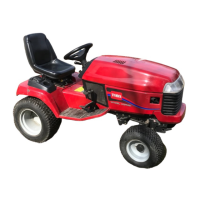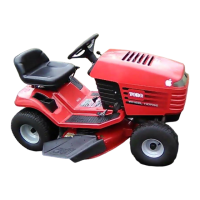Operation
17
Clutch
Pedal
(Fig. 7)—Used in conjunction with gear shift.
Depress clutch pedal fully when shifting gears and
whenever brake is used.
Brake
Pedal
(Fig. 7)—Must be depressed to slow down or stop the
rider. When pedal is depressed, a caliper engages the
brake disc at side of transaxle. Remember to depress
clutch pedal when using brake.
Note: Avoid depressing brake pedal while
clutch is engaged because premature
brake wear will occur. Do not rest foot
on pedal while mowing.
Parking Brake
Always set the parking brake when you stop the
machine or leave it unattended.
(Fig. 7)—Parking brake must be used in conjunction
with brake pedal. When pedal is depressed, end of
parking brake lever holds brake pedal in depressed
position and a caliper engages the brake disc at side
of transaxle.
Setting the Parking Brake
1. Depress brake pedal fully and shift transaxle to
neutral.
2. Move parking brake control sideward and release
brake pedal.
Releasing the Parking Brake
1. To release the parking brake, depress brake
pedal, and parking brake lever will return it to its
disengaged position. Release brake pedal slowly
.
4
1
3
2
Figure 7
1. Parking
brake
2.
Clutch pedal
3.
Brake pedal
4. Operating–in–Reverse
light
Starting
and Stopping
the Engine
Starting
1. Shift into neutral (N), move deck engagement
lever to DISENGAGE. Lock the parking brake.
Note: An interlock switch on the
transmission and deck engagement
(PTO) prevents the engine from
starting unless the operator is sitting on
the seat, the gear shift is in neutral and
the deck engagement lever is in the
DISENGAGE detent.
2. Move the throttle control to CHOKE position
(Fig. 6) when starting a cold engine. However, a
hot engine requires no choking. Move throttle to
FAST position for starting.

